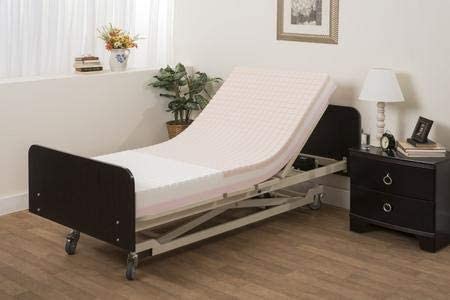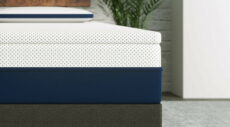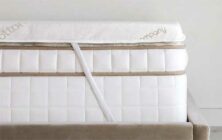Mattress toppers are very specific products whose purpose is to adjust the level of comfort of an existing mattress. However, when it comes to choosing a mattress topper for a hospital bed, we need to pay more attention because the topper should meet the needs and conditions of a patient who spends extended periods in bed.
To choose a mattress topper for a hospital bed, select a mattress topper that has a medium firmness and multiple pressure relief zones so that it prevents the development of pressure ulcers. This is especially important for patients who spend a lot of time in bed.
3 toppers we recommend for hospital beds
Mattress toppers can also increase the height of the mattress making it easier for patients to get in and out of bed. To learn more about the height of hospital beds, read this article from the Journal of Nursing Administration titled “ Height of Hospital Beds and Inpatient Falls: A Threat to Patient Safety.”
A hospital bed can be uncomfortable but with the addition of a mattress topper, their comfort can be substantially improved and offer the patients’ their much needed rest which assists recovery. Some toppers can improve blood flow, regulate body temperature, and cradle particular body parts like the patient’s head or heels. Read our article about choosing a mattress topper for proper neck support to find out more about preventing neck pain during sleep. Also, make sure to check out can you buy a pillow top for your mattress for additional options too.
You might also be interested in learning what air beds are used in hospitals too. Be sure to take a look at our related article to find out more information.
Reasons Why a Hospital Bed Can Be Uncomfortable
Staying in a hospital is generally not a pleasant experience. A hospital bed should be the most important aspect to consider when providing comfort for patients during their hospital stay.
Reasons why a hospital bed could be uncomfortable include the fact that hospital beds are designed for healthcare professionals instead of patients, they are smaller in size and mobile, and their mattress surface is slippery and lacks firmness.
Reason 1. Hospital Beds are Designed To Make Patient Care Easier
Hospital beds do not accommodate patients well, mostly because they are designed for the convenience of healthcare professionals and caregivers, who need to have easy access to patients. They are equipped with electronic devices and buttons to operate the bed and to make it easier on nurses to bend or to lift the bed. Some hospital beds have side rails that can be elevated or lowered, and prevent the patient from falling off the bed.
Reason 2. Hospital Beds Are Smaller In Size and Mobile
Hospital beds are small for space-saving needs and easy transport. They have wheels, which enable the movement of the bed within the same room or to another facility. They can fit in smaller areas such as hallways and elevators, and their narrower size means they can be arranged side-by-side in hospital wards and still allow for walking space for medical staff. The size of the bed may therefore be uncomfortable especially for taller or heavier patients. For more information about hospital beds and transportation, read this article from ScienceDirect titled “ Transportation with hospital beds”.
Related articles:
- Here are tips to choose a mattress topper for a heavier person
Reason 3. The Mattress Is Slippery and Lacks Firmness
Hospital beds need to be sanitized between use and are sometimes covered in PVC or other types of waterproof materials. The sheets can slide around on the PVC if not folded properly under the mattress, which causes patients to shift downwards as they sit or recline the bed. To prevent sliding, use this homecare mattress from Amazon which has a four-way stretch polyurethane cover which is easy to wipe and is machine washable. Furthermore, hospital beds mattresses aren’t firm enough to offer comfort and adequate body support as they are manufactured to be able to bend with the frame.
How Can You Choose a Mattress Topper to Prevent Bed Sores?
Constant rest, immobility, and physical confinement to a hospital bed for a long duration can cause bruises, bedsores, and even wounds on the skin. Hospital beds mattresses don’t support pressure points, which can also affect their blood circulation, patients’ muscles, and their entire body. The mattress may also make the patient hot and sweaty. Both pressure and moisture contribute to the development of bedsores. Read our article about solutions for fixing a mattress pad that causes hot or sweaty sleep.
To prevent bedsores, choose a medium firmness mattress topper that will cradle the patient’s pressure points and provide comfort and support. People who are prone to develop bedsores can use pressure relief mattress toppers to keep pressure off the affected area.
This ventilated gel-infused memory foam mattress topper from Amazon is a good option to treat and prevent the development of bedsores. It also helps the body keep a neutral spine alignment and prevents the body from overheating due to the cooling effect of the gel infusion.
How Do You Choose a Pressure Relief Mattress Topper for a Hospital Bed?
When looking for a pressure relief mattress topper, extra comfort, firmness, and support is essential. Pressure relief mattresses help distribute the body weight evenly while promoting a neutral spine alignment and proper blood flow. Read our article on the benefits of mattress toppers to find out more about the different firmness ratings to choose from. We’ve covered all the different mattress topper types in our ultimate guide.
To choose a pressure relief mattress topper for a hospital bed, select a topper that offers multiple pressure zones that evenly distribute the patient’s weight throughout the mattress.
A completely immobile patient would need a high-tech adjustable mattress topper (like this water-filled mattress topper from Amazon) that can be inflated and deflated at set times to ensure that no area of the body remains under pressure for too long.
Air-filled mattress toppers, foam-filled mattress toppers, and gel mattress toppers are also recommended to relieve pressure on the hips, shoulders, and elbows. These mattresses are not adjustable but they do conform and mold to the patient’s body.
Take a look at this article from Purdue University to learn more about how a mattress responds to pressure distribution.
Recommended Mattress Toppers for Hospital Beds
Mattress toppers are available with various features to meet particular preferences and requirements. Since hospital beds are known to be uncomfortable, mattress toppers can be added on top of the mattress to ensure a more comfortable sleep during a hospital stay. Make sure you also get a non-vinyl waterproof protector for your mattress topper so that your topper is well ventilated and comfortable to sleep on. Here’s a guide describing how to protect a mattress topper with product recommendations.
A mattress topper for a hospital bed may add thickness to the mattress, adjust the firmness of the mattress, relieve pressure, treat or prevent the development of bedsores, regulate temperature, and improve blood circulation.
Here is a list of mattress toppers for hospital beds and the conditions they can help relieve:
| Mattress Toppers for Hospital Beds from Amazon | What condition does this product help with? | Price |
| Pressure Redistribution Foam Hospital Bed Mattress – 3 Layered Visco Elastic Memory Foam | This product distributes the patient’s weight evenly to reduce the risk of bedsores development. | ~$270 |
| Vaunn Medical Cloud Air Whisper Quiet Alternating Air Pressure Mattress Topper with Pump | This product eliminates pressure, distributes weight evenly, and increases blood circulation. | ~$45 |
| Sleep Innovations 4-inch Dual Layer Gel Memory Foam Mattress Topper Enhanced Support | This product regulates temperature and helps you stay cool as you sleep. | ~$80 |
| ViscoSoft 3 Inch Memory Foam Mattress Topper Twin | This product relieves pain and reduces pressure points. | ~$120 |
| Recci 2-Inch Memory Foam Mattress Topper | This product helps regulate temperature and relieves pressure points. | ~$75 |
Since hospital beds are a little more unique, make sure you also take a look at our article what’s the weight of a mattress topper before making any firm decisions. Also, you may find more useful information in our article on how to fix a lumpy mattress topper too.
Will a Water-Filled Mattress Topper Help Make a Hospital Bed More Comfortable?
A water-filled mattress topper is made with internal pods—called baffles—which help distribute the patient’s body weight evenly. Water-filled mattress toppers change the mattress’ level of support by inflating and deflating the mattress in different locations.
A water-filled mattress topper will make a hospital bed more comfortable because it offers isolated support that can be adjusted that balances the patient in the center of the mattress and provides a cooler and more comfortable sleeping surface on hospital beds.
A water-filled mattress topper ensures no pressure point remains under pressure for too long so that the patient will wake up feeling rested. Water-filled mattress toppers also promote proper ventilation around the mattress and do not retain body heat and sweat, all of which prevent parasites and mildew from being trapped inside the mattress.
Mattress Toppers vs. Mattress Overlays vs. Mattress Pads: A Comparison
When deciding between a mattress topper, mattress overlay or mattress pad it is important to determine what requirements are being sought. Read our article comparing mattress pads and mattress covers for a more in-depth discussion of their specific uses.
Mattress toppers, mattress overlays, and mattress pads are different in terms of their purpose, material composition, thickness, density, and price. Mattress toppers provide an extra layer of comfort and support to a mattress. Mattress overlays are thinner and enhance the comfort of the mattress. Mattress pads are used to protect mattresses against dust, dirt, spills, and contaminants. All three products extend the mattress’ longevity.
Comparing Mattress Toppers, Mattress Overlays, and Mattress Pads
Here’s a summary of the difference between mattress toppers, overlays, and mattress pads:
| Features | Mattress Toppers | Mattress Overlays | Mattress Pads |
| Primary purpose | Provide extra cushioning and support | Provides extra comfort and pressure relief | Protect your mattress from dirt and spills |
| Types of Materials | Memory foam, wool, latex, fibers and feathers | Eggshell foam, memory foam, latex | Polyester, wool, cotton, down |
| Thickness | 2 to 4 inches | 3.5 inch | 1 inch |
| Density | 3.5 lbs | 2.5 lbs | 2 lbs |
| Lifespan | Depends on materials, up to 7 years | 5 years | Up to 4 years |
| Price | ~$200 | ~$100 | ~$50 |
| Example Product | BedStory 4 Inch Memory Foam Mattress Topper | Drive Medical Premium Guard Gel Mattress Overlay | Woobobee Queen Mattress Pad |
You may also be interested in learning how to store a latex memory topper in our related article too.
Other Tips to Make A Hospital Bed More Comfortable
As mentioned previously, mattress toppers are good options for making hospital beds more comfortable, but there are other alternatives worth mentioning.
To make a hospital bed more comfortable, try to incorporate ergonomic accessories, a remote to operate the bed, and choose high-thread count cotton sheets.
Tip 1. Incorporate Ergonomic Accessories
When spending a long time in bed, incorporating additional accessories to the bed can make a tremendous difference in terms of comfort. Bed rails for instance, act like barriers to prevent patients and items from falling off the bed. They also help patients get in and out of the bed more easily. Grabbers are efficient in helping patients reach and move items on their own. Overtables for hospital beds are also beneficial as they provide a surface for eating, reading and using a laptop. Hanging caddies can also be attached to the bed to keep necessary and personal items within the patient’s reach. We like this bed rail from Amazon because it has many useful features including a rotating arm for holding devices like an iPad or tablet.
Tip 2. Add a Remote To Operate the Bed
People with limited mobility struggle to shift position when lying in bed. A remote can help them adjust the position of the bed the way they please. Providing patients with the ability to choose and change their bed configurations gives them the freedom to adjust the bed to their desired position and comfort level.
Tip 3. Choose High-Thread Cotton Sheets
The sheets can greatly contribute to the comfort of hospital beds. Cotton or bamboo fabrics are ideal for hospital beds because their natural fibres don’t make the patient overheat. Choose cotton with a thread count above 180 to promote softness and comfort. Here are some 800 thread count cotton sheets that are extremely soft and have great reviews.
For more details about user comfort in hospital beds, read this article titled “ A Study on Examining User Comfort in Hospital Beds”. You may also find a lot of useful information in our article on how to fix a mattress topper that’s too warm.
In a Nutshell
Though hospital beds are narrower and slightly less comfortable than normal beds, mattress toppers can improve their comfort and offer additional support, especially for relieving pressure points that are associated with long confinement for medical reasons. Mattress toppers can alter the firmness or softness of a mattress and assist with creating the optimum support and comfort to ensure a restful sleep. Read our other article on how to hold down a mattress topper to prevent slipping and sliding as well as when we recommend buying a mattress topper.




